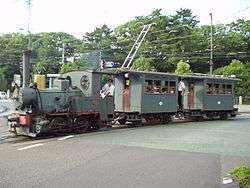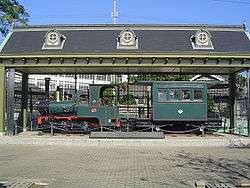Botchan Ressha

The Botchan Ressha (坊っちゃん列車) is a diesel-powered replica of a small-gauge steam locomotive installed in the city of Matsuyama, Ehime, Japan in 1888 as the original Iyo Railway. "Not only was it the first railway in Shikoku but it was also the third private railway in Japan."[1] The reconstructed locomotives are now a tourist attraction, alternating with electric trams on two of the Iyo Railway's city lines.
The original railway

The original 0-4-0 (B) type steam locomotives built by Krauss & Company in Munich were imported to Matsuyama in 1888. The narrow-gauge (2 ft 6 in/762 mm) locomotives used Stephenson valve gears and ran on coal. The 4.5 mile line ran every hour from Mitsuhama to Togawa (now Matsuyama City Station) stopping at Komachi station. In the 1894 Murray's Handbook Chamberlain and Mason wrote, "This is a pretty little journey across the mountain-girt plain, in whose centre rises the wooded hill crowned by Matsuyama castle, which comes in view before reaching the intermediate station of Komachi."[2]
The train was small even by narrow-gauge standards, as passengers almost invariably noted. Osman Edwards, who visited Matsuyama in 1898, wrote "Dōgō is only a short distance from the seashore, and is reached in half-an-hour by what I can only describe as a toy train."[3]
Demise and rebirth

The original trains were decommissioned after Iyo Railway (Iyotetsu) introduced electric cars in 1931. During subsequent decades, Iyotetsu made efforts to preserve the legacy of the original trains, due to their historical value and association with Sōseki's famous novel. These efforts included preservation of one of the original locomotives, dubbed "Botchan." As a historian noted in 1995, "The Krauss and an original car are kept in a kind of iron cage in the city's Baishinji Park. Its label reads 'No. 2585 München 1888.'"[4]
On October 12, 2001, a diesel-powered replica was introduced by Iyotetsu. Currently, the Botchan Ressha runs on two of the Iyotetsu city lines: ten round trips daily on the Jonan line (from Dogo to Matsuyama City Station) and four round trips daily on the Hanazono line between JR Matsuyama Station and Dogo, stopping at Komachi.
Cultural references
A character in Eliza Scidmore's 1907 novel, As the Hague Ordains comments: "Such a railway! The tiniest miniscule[sic] of a railway — a string of netsukes is the train. I might hang the locomotive on my watch chain — a breloque merely. So droll."[5]
Most famously, the train was depicted in Natsume Sōseki's 1906 novel, Botchan: "I found the train station soon enough and bought myself a ticket. When I got on the train, it looked as dinky as a matchbox. It had hardly started to get rolling when it was already time to get off; the whole ride couldn't have taken more than five minutes. No wonder the ticket was so cheap, I thought — only three sen!"[6]
References
- ↑ Kishi, Yuichiro (2004). "Railway Operators in Japan 13: Shikoku Region". Japan Railway & Transport Review (39): 44.
- ↑ Chamberlain, Basil Hall; Mason, W.B. (1894). A Handbook for Travellers in Japan (4th ed.). London: Murray.
- ↑ Edwards, Osman (1901). Japanese Plays and Playfellows. London: Heinemann. p. 200.
- ↑ Finn, Dallas (1995). Meiji revisited: the sites of Victorian Japan. New York: Weatherhill. p. 141.
- ↑ Scidmore, Eliza (1908). As the Hague Ordains. New York: H. Holt. p. 37.
- ↑ Sōseki, Natsume (2007). Botchan: A Modern Classic. Joel Cohn translator. Kodansha. p. 27. ISBN 4770030487.